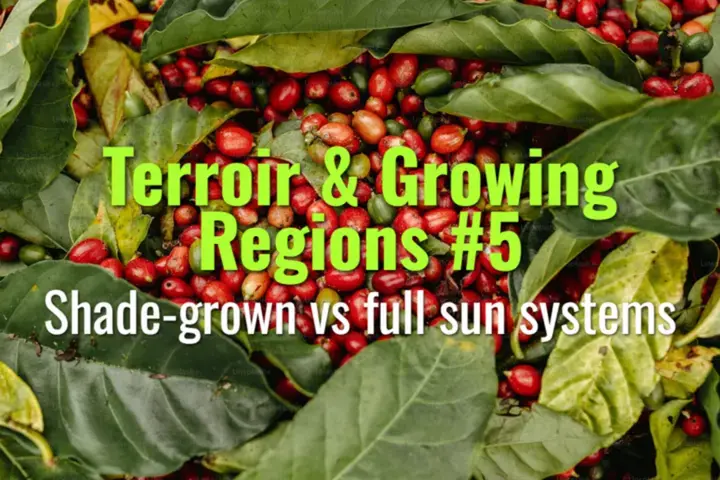Shade-grown vs full sun systems
This topic explores the differences between shade-grown and full sun coffee cultivation systems, their impact on yield, quality, biodiversity, and long-term sustainability.
- Coffee Basics Nerds
- 2 min read
Article 5 of 12 in Terroir & Growing Regions/

Shade-Grown Systems
- Natural setting: Mimics coffee’s original understory environment in African forests.
- Benefits:
- Slower cherry maturation → denser beans, higher flavor complexity.
- Reduced plant stress from heat and drought.
- Supports biodiversity: birds, pollinators, and beneficial insects.
- Enhances soil fertility through leaf litter and organic matter.
- Challenges:
- Lower yields compared to sun-grown systems.
- Requires more land to maintain equivalent output.
- More labor-intensive pruning and management.
Full Sun Systems
- Modern practice: Promoted since the mid-20th century for maximizing productivity.
- Benefits:
- Higher yields per hectare.
- Easier mechanization and large-scale farming.
- Faster cherry ripening reduces harvest cycle.
- Challenges:
- Greater exposure to pests and diseases.
- Increased need for chemical inputs (fertilizers, pesticides).
- Soil erosion, nutrient depletion, and reduced long-term sustainability.
- Coffee quality often lower—less complex flavors, lighter acidity.
Hybrid/Intermediate Approaches
- Managed shade: Some farms use partial shade with selected tree species to balance yield and quality.
- Agroforestry systems: Coffee integrated with fruit or timber trees provides diversified income.
- Climate adaptation: Shade trees buffer against rising temperatures and irregular rainfall.
Quality and Market Perception
- Specialty sector: Prefers shade-grown coffee due to complexity, density, and environmental sustainability.
- Commodity market: Favors full-sun systems for volume and efficiency.
- Certification: Shade-grown practices often linked to eco-labels (e.g., Rainforest Alliance, Bird Friendly).
Lasting Importance
Shade-grown vs full sun reflects the trade-off between quality and yield. Shade systems favor sustainability, biodiversity, and specialty value, while full sun favors volume and profitability. The future of coffee may depend on finding a balance—leveraging agroforestry and improved varieties to sustain both farmers and ecosystems.
You might also like:
- Tags:
- Lasting Importance
- Coffee Quality
- Organic Matter
- Rainforest Alliance
- Labor Intensive
- Flavor Complexity
- Lower Yields
- Yield Quality
- Large Scale
- Shade Trees
- Pests Diseases
- Soil Fertility
- Term Sustainability
- Higher Yields
- Quality Market
- Denser Beans
- Climate Adaptation
- Future Coffee
- Cherry Maturation
- Maturation Denser
- Balance Yield
- Complex Flavors
- Rising Temperatures